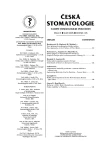Attachment of Composites to Hard Dental Tissues and Morphological Comparison of Effects of Two Adhesive Techniques
Připojení kompozitů k tvrdým zubním tkáním a morfologické srovnání efektu dvou adhezivních technik
Úvod:
V úvodu je podán přehled o současném stavu problematiky připojení kompozitních materiálů k tvrdým zubním tkáním.
Cíl:
Cílem práce bylo vyšetřit a porovnat vzhled skloviny a dentinu po adhezivní úpravě totální leptací technikou a po ošetření kyselým primerem samoleptacího adheziva.
Materiál a metody:
K experimentu bylo použito 30 premolárů extrahovaných z ortodontických důvodů. Extrahované zuby byly rozděleny do skupin po pěti. Leptací gel kyseliny ortofosforečné byl použit na sklovinu bez zábrusu, jakož i na sklovinu zbavenou zábrusem nejpovrchovější vrstvy. Po opláchnutí a osušení byl takto preparovaný povrch skloviny pozorován v elektronovém mikroskopu. Za účelem vyšetření adhezivní přípravy dentinu byl u 10 vzorků standardním brouskem proveden zábrus k obnažení dentinu a vytvoření smear layer. Takto připravený dentin byl ošetřen u pěti vzorků kyselinou ortofosforenčou a u pěti vzorků kyselým primerem. Vzorky byly pozorovány v elektronovém mikroskopu.
Výsledky:
Bylo zjištěno, že sklovina ošetřená kyselinou ortofosforečnou vykazuje členitější a pro mechanickou adhezi kvalitnější povrch než sklovina ošetřená samoleptacím primerem. V morfologii povrchu dentinu nebyl mezi oběma způsoby ošetření prokázán rozdíl.
Závěr:
Samoleptací adheziva mají opodstatnění v případech, kdy jsou k dispozici rozsáhlejší plochy dentinu. Zde je menší riziko netěsnosti v připojení výplně.
Klíčová slova:
adheze – adhezivum – primer – samoleptací adheziva
Authors:
L. Roubalíková 1; R. Autrata 2; P. Wandrol 2
Authors‘ workplace:
Stomatologická klinika LF MU a FN U Sv. Anny, Brno
přednosta prof. MUDr. J. Vaněk, CSc.
1; Ústav přístrojové techniky AV ČR, Brno
ředitel RNDr. L. Frank, DrSc.
2
Published in:
Česká stomatologie / Praktické zubní lékařství, ročník 105, 2005, 5, s. 92-99
Category:
Overview
Introduction:
The authors review the present state of the problems in connecting composite materials to hard dental tissues.
Objective:
The aim of the work was to examine and compare the appearance of enamel after adhesive adjustment (adaptation) by a total etching technique after treatment with an acid primer of the self-etching adhesive.
Material and Methods:
The experiment was made with 30 premolars extracted for orthodontic reasons. The extracted teeth were divided into groups, five premolars each. The etching gel of orthophosphoric acid was used for enamel without grinding as well as for enamel freed of the most superficial layer by grinding. After rinsing and drying the enamel prepared in this way was observed by electron microscope. In order to examine the adhesive preparation of dentine, grinding for denuding the dentin and formation of smear layer was made in 10 samples. The dentin prepared in this way was treated in five samples with orthophosphoric acid and by an acid primer in five other samples. The results were examined by electron microscope.
Results:
It has become obvious that the enamel treated with orthophosphoric acid displayed a jaggier surface of better quality for mechanical adhesion than the enamel treated with a self-etching primer. In the morphology of dentine surface there was no difference between the two ways of treatment.
Conclusion:
The self-etching adhesives are substantiated in cases, where more extensive atreas of dentine are available. They represent a lower risk of tightness in joining the filling.
Key words:
adhesion – adhesive – primer – self etching adhesive
Labels
Maxillofacial surgery Orthodontics Dental medicineArticle was published in
Czech Dental Journal

2005 Issue 5
- What Effect Can Be Expected from Limosilactobacillus reuteri in Mucositis and Peri-Implantitis?
- The Importance of Limosilactobacillus reuteri in Administration to Diabetics with Gingivitis
Most read in this issue
- Diagnostic Possibilities in Impacted Teeth with Horizontal Position Near to Middle Palate Suture
- New Approaches to the Problem of Third Molar
- Augmenting Materials Used in Dentistry – Present State
- Gingival Changes after Immunosuppressive Therapy II.
